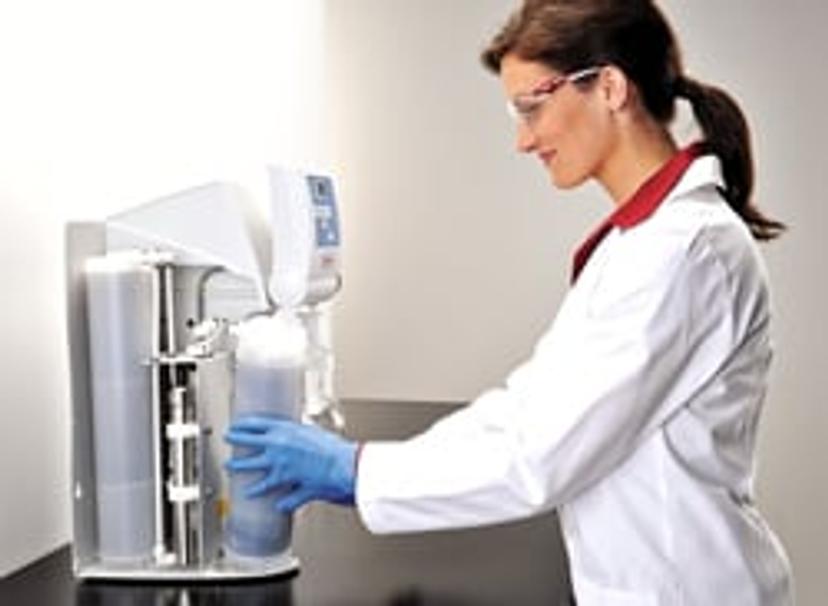Tips for Maintaining Water Purity in the Lab
13 Apr 2015
Water is an essential component to many lab applications, and most of us will use it all the time, from diluting sensitive samples and preparing media, to cleaning laboratory equipment. Tap water, however, can contain many impurities and contaminants that may impact the accuracy of resulting data.

Laboratory water purity levels have been classified by numerous professional organizations, and they all have similar parameters for the maximum contaminant levels permitted. For example, the American Society for Testing and Materials (ASTM) International classifies water on its level of purity, ranging from Type 1-4. Understanding these purity levels is critical to selecting the right type of water to meet the needs of a specific application. Type 1 or ‘ultrapure’ water has the lowest levels of all ions, particulates, pyrogens, and bacteria, making it optimal for highly sensitive techniques. For less critical applications such as rinsing and media preparation, Type 2 or ‘pure’ water is generally sufficient. Choosing a system to ensure that water is supplied at the correct purity level for your lab is an important task. Proper maintenance of the system will help ensure water quality remains consistent through the life of the water system. Here, we take a closer look at each purification technology and provide tips for how to best maintain water purity.
1. Distillation
Distillation removes most contaminants to provide Type 2 water. Impurities are removed when the water changes into a gaseous state, and the purified water is obtained when it recondenses into a separate vessel. While distillation is a slow process, it doesn’t require the use of any consumables, which removes many additional costs.
Tip: When using this system, the water in the storage reservoir needs to be used regularly to avoid bacterial contamination. Users should also clean the boiling chamber to remove the build-up of hard water deposits that could reduce the lifespan of the heating elements. When cleaning, check the integrity of the tubing, and replace if required.
2. Reverse Osmosis (RO)
Reverse osmosis uses a semi-permeable membrane to remove over 90 percent of impurities from tap water. Its filtration potential is dependent on the quality of the feedwater and the age of the RO membrane. For this reason, it serves as an ideal pre-treatment process for producing ultrapure Type 1 water. During the process of reverse osmosis, applied pressure forces tap water through the microporous membrane. The membrane surface traps the bacteria, organics and ions and flushes them to a drain. The purified water is then collected into a storage tank.
Tip: Rather than waiting for the membrane to degrade from regular usage, it is good practice to change it every two years, or as specified in the system’s operational manual. If users are changing it themselves, they should take careful note of the manufacturer instructions, as the new membrane may need to be flushed before use. To lengthen the usage life of the RO membrane and protect it from particular impurities in the tap water, it is important to have a carbon cartridge, particle filter and a water softener or hardness stabilizer.
- Carbon cartridges reduce chlorine: Depending on the type of membrane in use, chlorine in the water will likely cause degradation over time. To avoid this, a carbon cartridge can be used to remove any traces of chlorine before the water reaches the membrane.
- Particle filters remove particulates: The reverse osmosis membrane can’t tolerate particulates since they can block pores, or worse, tear holes. Users can combat this issue by using a prefilter to catch large particulates before they reach the membrane. As a general rule, pre-filters should be changed every six months, unless indicated otherwise.
- Water softener or hardness stabilizer reduces hardness: Tap water is generally ‘hard’ due to the presence of calcium and magnesium ions, which cause damage to the membrane over time. A water softener, or hardness stabilizer crystals, will reduce the water’s hardness and, as a result, reduce its role in membrane degradation.
3. Deionization
This process is designed to remove dissolved inorganic compounds found in water using a cartridge that contains resin(s). Resins have an affinity to the dissolved ions, enabling them to exchange ions freely with hydrogen and hydroxide ions to form water. Thermo ScientificTM BarnsteadTM Type 1 and Type 2 systems utilize this technology.
Tip: To avoid bacteria growth, the deionization cartridge should be replaced at least annually, or when the purity of the produced water drops below acceptable levels. Disinfecting the system annually is also recommended. Thermo Scientific™ Deionization Cartridges feature a quick-connect design, allowing fast and easy change-outs without the need to depressurize the entire system..
4. Adsorption
Adsorption uses an activated carbon surface to attract organic molecules and chlorine, ultimately removing them from the water.
Tip: If using a carbon cartridge to remove chlorine before a reverse osmosis membrane, regularly check the RO concentrate reject water for chlorine breakthrough. If breakthrough occurs, you should promptly replace the exhausted carbon cartridge with a new one.
5. Ultraviolet (UV) Oxidation and Ultrafiltration
Ultraviolet oxidation involves the use of UV light with a 185/254 dual wavelength to oxidize organic compounds and destroy any residual bacteria. This is often used in conjunction with an ultrapure cartridge for deionization, and an ultrafilter to remove any remaining traces of pyrogens and nucleases.
Tip: The UV light and ultrafilter in a Thermo Scientific Barnstead lab water system are designed to be changed every two years. When changing the UV light, you need to wear gloves, as natural oils can reduce the lifespan of the light. When changing the ultrafilter, it must be secured firmly at the three connection points, and flushed before use.
6. Final Filtration
Final filtration is the process of using an absolute filter to remove particulates, bacteria or resin beads from the feedwater.
Tip: The filter needs to be changed every three months as bacteria can grow if water collects on the membrane. It can sometimes be autoclaved and used multiple times, but you should consult the water system’s operational manual for details. Because final filters are often out of the recirculation loop, it is also a good practice to rinse a little bit of water through the final filter before use.
Each water system has its advantages and limitations, and choosing the right one depends on the application. The Thermo Scientific Barnstead Water Purification portfolio includes Type 1, Type 2 and RO systems and consumables that meet the needs of the most critical and everyday water requirements.
By Kim Knepper, Global Water Applications Specialist, Thermo Fisher Scientific
